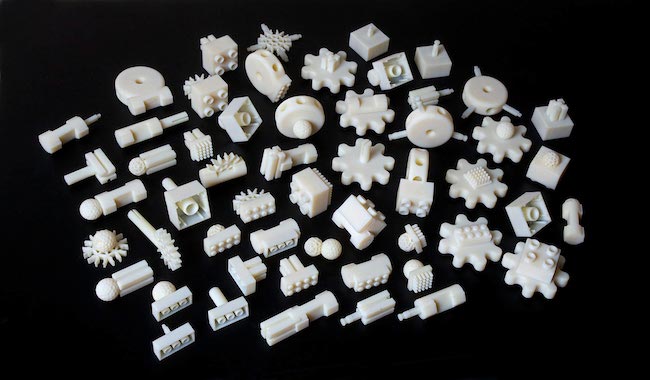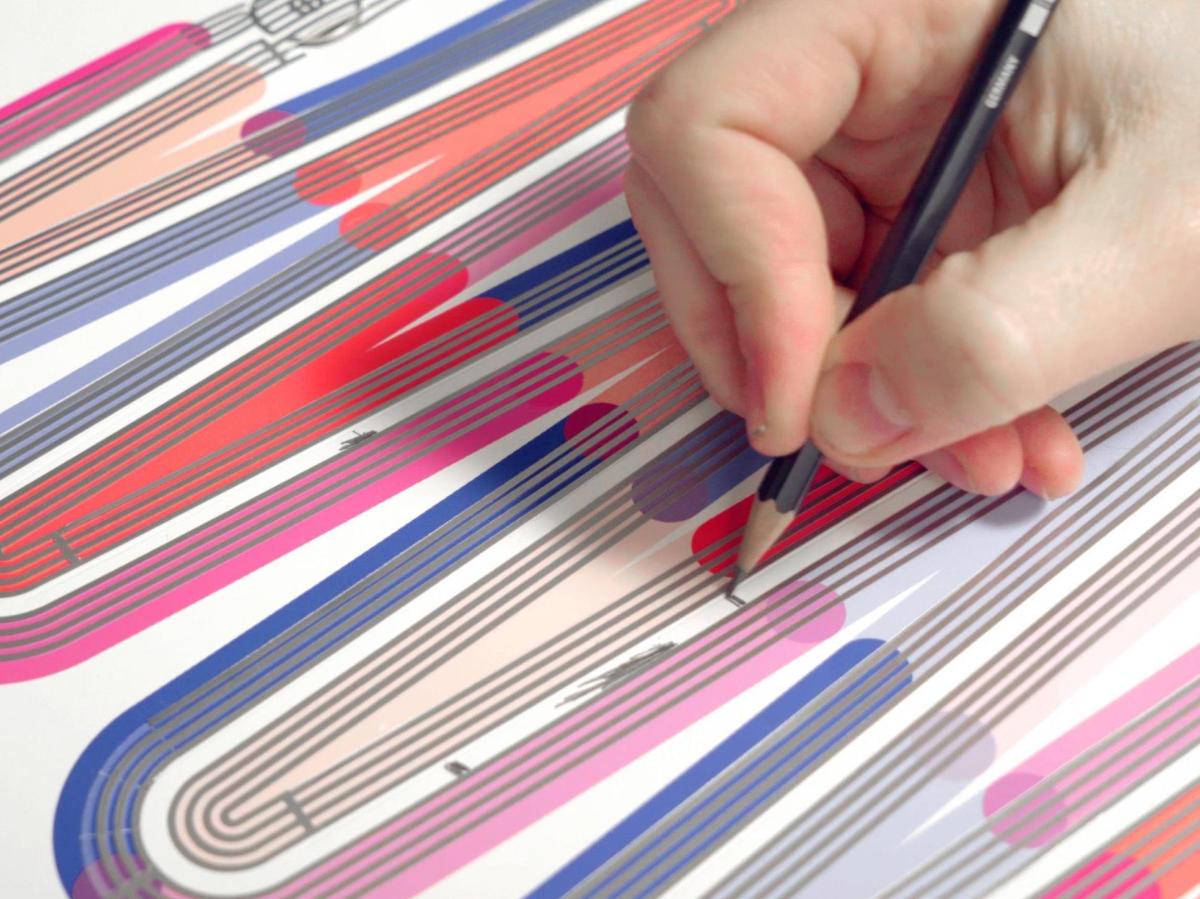Studio Pinaffo Pluvinage, France, Papier Machine, 2018
In 2014, teenager Adrianna Mitchell sat at a keyboard with Barack Obama and helped him become the first US President to code. His modest effort, a mere 17 characters of script, underscored a deeper belief in coding as the literacy of the 21st Century.
While curator and designer, Aaron Seymour makes this point, he equally feels that the hype surrounding a new coding literate generation is a bit of a myth.
‘I don’t entirely buy the line that code is the literacy of the 21st century. We all carry around incredibly powerful computers in our pockets (aka smartphones), which have transformed our businesses, our social live, and yet we do not understand how they work. Similarly, I happily drive a car and do not know how to repair it. What is useful is that students, at any age, make technology their own in some way,’ said Seymour.
He examines the role that code is playing in contemporary design in the exhibition, HELLO WORLD: CODE AND DESIGN, which opened this week at UTS Gallery, Sydney.
HELLO WORLD examines that intersection where code impacts design through the work of twenty-five designers from around the world, and who are using code in everything from 3D printing, fashion and textile design and fabrication, paper and publishing.
Seymour said that while his children are taught basic coding at school, there are other things that have happened over the last 10-years that also sit at this intersection of technologies, such as digital fabrication and the rise of 3D printing – now affordable at just $300 from Aldi (supermarket).
‘This means that code is escaping the black box of the computer,’ he added.

Defense Distributed The Liberator, 2013, 3D video likeness of 3D printed gun
The democratic climate of code
Perhaps the most speculated example of how the availability of code has impacted design is 3D printable handgun “The Liberator”, designed by Defense Distributed.
Defense Distributed published the plans online in May 2013 through open source as the first printable firearm. These plans were downloaded over 100,000 times in two days before the United States Department of State demanded that the plans were retracted. Despite that, they remained available on file sharing websites while Defense Distributed’s Texas-based owner, Cody Wilson, fought for the right to distribute his gun.
This month the US Department of Justice reached a settlement, allowing the sale of plans for 3D-printed firearms online, beginning 1 August, 2018. In a statement this week, Wilson said on his website: ‘The age of the downloadable gun formally begins.’
While the actual gun is not shown in this Sydney exhibition – Seymour said it’s illegal to produce it in Australia – he has included it as an ethic case for consideration. ‘One of the things this exhibition also does is situate these practices within broader social, economic and political concerns,’ he said.
‘There is a lot of utopian promises around these technologies. And while every new technology brings new advantages, there are also new dangers as well, and one needs to question those,’ he added.
Original copies of the Liberator have been acquired by the Victoria and Albert Museum in London and a copy of the gun is on display at London’s Science Museum.

Golan Levin, Shawn Sims, Free Universal Construction Kit(F.U.C.Kit), 2012, 3D printed digital models
Seymour explained that there are several designs in the exhibition that use open source.
The flipside to The Liberator, it could be argued, is Golan Levin and Shawn Sims’ Free Universal Constructor Kit (F.U.C.Kit).
Described as a matrix of adapter bricks that allow ten popular kids construction toys (Lego, Duplo, Tinkertoys etc) to be used together without any proprietary or corporate interests. Simply, download the code and print your “joiner blocks” at home on your 3D machine.
Levin says: ‘The Free Universal Construction Kit is not a product, but a provocation.’ Seymour added that it prompts conversations about intellectual property rights and open source culture.
He continued: ‘In the process of prising open the lid on modern technology, these designers are experimenting with new ways of being digital. Low cost electronic components, and the physical computing and maker cultures they’ve spawned, now see code at work in everything from simple household items and toys to weapons and wearables.’
Distribution and manufacture is incredibly centralised today, and we also see that having the capacity to shift, says Seymour. ‘Today you can customise your NIKE trainer completely online, and have it built in an offshore factory and delivered in time.’
Seymour has included Iris van Herpen’s 3D printed clothing and accessories in this exhibition to demonstrate how this material world is becoming increasingly fertile.
Alongside 3D printing, there is a strong emphasis on the book within HELLO WORLD, with works by Joshua Roseberg, Ben Fry, Matt Pyke, Helen Yentus and Studio Pinaffo Pluvinage all focusing on this form.

Wang & Söderström (designers), Unique Board (manufacturer), Excavation I, II, III, 2017; Full color 3D printed plaster, resin.
Will 3D print code be as widely embraced as Netflix?
In HELLO WORLD’s catalogue essay, writer Tom Lee’s compares the on-demand self-directed capacity of 3D design with streaming servers, Spotify and Netflix, in its ability to transform our relationship with objects.
Seymour said that while he thinks 3D printers are amazing, we will not be using them with any great complexity real soon.
‘In the same way that I can buy a sewing machine for $80 but don’t make my own clothes, or I buy a 3D printer and not make own cutlery. Rather there is a shift around models of ownership. For example, a work in the exhibition by (manufacturers) Unique Board, Excavation I, II, III, is really interesting for their business model. They offer limited-run 3D printed objects on 90-day design release – so they are released by time, not by edition number. That is an interesting shift,’ explained Seymour.
Lee continued: ‘The company uses Instagram as channel to initiate collaborations on 3D printed sculptures with artists and creatives who are doing interesting work. The number of sculptures produced is limited by set period of three months.
‘While it might be tempting to focus on the more glamorous and revolutionary possibilities associated with technologies such as 3D printing, their production model exemplifies the ways in which our dynamically evolving, socio-technical ecology is influencing cultural expression, consumer products and production,’ said Lee.
Lee reminds that their business model is contingent on multiple technologies, such as the camera enabled smartphone, image sharing services, computer aided design and 3D printing – and of course, a sharing culture.
Altering perceptions; shaping futures
Long gone are the days when code was a stream of green numbers spewing across a computer monitor.
‘We have this vision of what coding might be – some geek tapping away to 3:30am drinking lots of red bull. A software engineer would be insulted,’ said Seymour.
Design is an interesting way to look at code as it presents a different image of how code is integrated into what designers do. Design is also interesting as a field as it crosses over so many other fields, and collaborations are happening all the time. Seymour likes to think of them as ‘eruptions’.
He added that, absolutely, one of the objectives of this exhibition was to show, from a professional development and career perspective, the diversity with which code is integrated. ‘Code is not relegated exclusively to software engineers,’ he said.
‘I started designing a website 25 years ago and had to program it all; now people can design and be fluent without getting under the hood. There are enormous possibilities for non-specialities to embrace code.’He reminded that a lot of these glossy frictionless transactions have online have all material repercussions in the world. ‘We think of code as this abstract thing, but when you buy online this whole set of things kick into play – structure around labour practices, legal infrastructure, energy use. For example Bitcoin currently draws more energy than New Zealand. So there are environmental and energy concerns as well as ethical and social ones that underline coded technology driven access.
‘What I am trying to say is, there are other ways code is escaping computers – it’s not just grainy text you see on the screen – what I have tried to do with this exhibition is to choose objects that hint on some to these topics,’ he concluded.
Curated by Aaron Seymour
24 July—14 September 2018
Artists: A2-Type, Alterfact, Aaron Koblin, Ben Fry, Ben Roberts, Defense Distributed, Golan Levin, Helen Yentus, Humanoid, Iris Van Herpen, Josh Roseberg, Kouhei Nakama, Leah Buechley, Reinoud van Laar, Shawn Sims, Shih Wei Chieh, Studio Pinaffo-Pluvinage, Takashi Kawashima, Tristan Perich, Universal Everything, Wang & Söderström, Ying Gao, and Zeitguised




